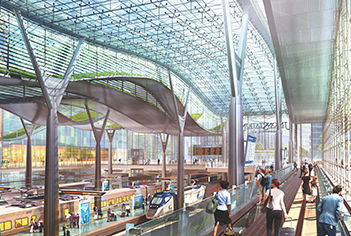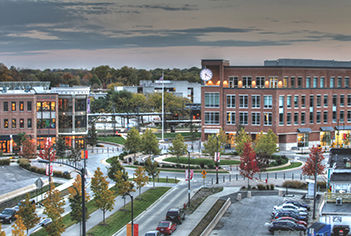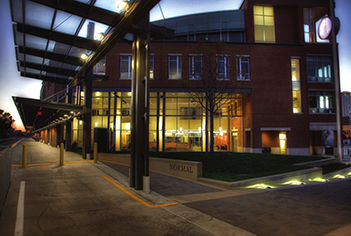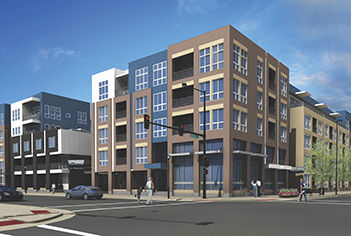In the last decades of the 20th century, many of the projects undertaken during the golden era of railroad station restorations across the country involved anything except trains. Union Station in St. Louis, for example, reopened as an urban mall. Stations in Dallas and Jacksonville, Florida, became parts of convention centers. Union Station in Indianapolis was packed with bars and nightclubs. The Cincinnati and Kansas City stations had museums created inside them.

The Train Shed planned for Burnham Place at Union Station in Washington, D.C.
“What we’re seeing now is a real resurrection of train transportation in the United States,” says Rod Diridon Sr., executive director of the Mineta Transportation Institute, a public policy research center in San Jose, California. “We’re going to see a wholesale return of integrated rail transportation and the return of the station as the iconic focal point in downtowns.”
At Amtrak, the national intercity rail service, the station planning department has become so busy that it now monitors active railroad station plans and projects across the country. Its list is up to 150 facilities, according to John Bender, a program manager for Amtrak station planning. He says this activity level reflects surging passenger travel—from 21 million passengers in fiscal year 2000 to 31 million in fiscal 2012—necessitating new and larger stations to alleviate overcrowding in Amtrak shelters so tiny and dingy that some have come to be disparaged as “Amshacks.”
“Ten or 15 years ago, it was rare for a community to propose a new Amtrak station, but in the past few years, it has just ballooned,” Bender says. “It’s not just a big-city phenomenon; it’s also something that smaller towns are doing.” (Amtrak stations are typically developed by a city or state government, as Amtrak owns only about 13 percent of the stations its trains use.)
“Indeed, cities and towns have taken a variety of approaches to railroad station projects. Several different types of plans are completed or underway:
-
Renovations of older stations that have been vacant or underused. This is occurring in Springfield, Massachusetts; St. Paul, Minnesota; Wichita, Kansas; and Denver. The St. Paul station opened in December; Denver’s is under construction; engineering work has started on Springfield’s; and a developer has announced plans to redevelop Wichita’s. (See “Linchpin of the West,” Urban Land, July/August 2012, for an overview of the Union Station project in Denver.)

Uptown Circle anchors the Uptown Station Development in Normal, Illinois. The traffic circle evolved into a civic gathering place with green features that benefit the community, leading to the roundabout being named a winner of the National Award for Smart Growth Achievement by the U.S. Environmental Protection Agency in 2011.
-
Construction of entirely new stations. This is popular in small and medium-sized cities, such as Birmingham, Alabama; Normal, Illinois; Raleigh, North Carolina; Roanoke, Virginia; and Rochester, New York. The station in Normal opened last year; the projects in Birmingham, Raleigh, and Rochester are in the design stage; and the project in Roanoke is on the drawing board and not yet funded.
- Modernization and expansion in and around larger stations. This is happening in Washington, D.C.; New York City; Chicago; Baltimore; and Sacramento, California. All these involve real estate development: a historic building is being renovated in New York; master plans have been unveiled in Washington, Chicago, and Baltimore; and Sacramento officials are still studying options.
- Long-range planning for high-speed rail. Communities across California, along with big cities ranging from Miami to Philadelphia, intend to accommodate future bullet trains in multimodal or stand-alone stations. In California, multimodal stations are under construction in San Francisco and Anaheim, and sites have been selected in Los Angeles and Fresno; new projects are under discussion in Miami and Philadelphia.
One commonality among all these different station projects and plans is a downtown location, so municipal officials hope the new or renovated stations serve as catalysts for additional downtown redevelopment. It is already happening in some cities. The new station in Normal has attracted new hotels close by. Denver’s renovation is already luring new apartments to the neighborhood. And last year, when an executive announced the relocation of his high-tech firm to Raleigh, he cited the proposed rail station as one of the site’s attractions.
Thus, improved train stations are another magnet—like libraries and arts centers—that cities are pursuing to help revive their downtowns.

Uptown Station in Normal, Illinois. Rail tracks and platform are to the left of the building.
“What local governments increasingly understand is station redevelopment as an economic development tool,” says John Robert Smith, a former mayor of Meridian, Mississippi, who now is president of Reconnecting America, a Washington, D.C.–based nonprofit organization that promotes transit-oriented development.
Renovations
Almost all of America’s iconic Union Stations—so called because they were built as joint ventures, or “unions,” of several independent railroads—were revitalized in the 1980s and 1990s. After that, interest in railroad station restoration waned, as local governments turned their attention to commuter-rail facilities and federal incentives for station restorations waned. During the 2000s, websites like Railway Preservation News went dark, and organizations like the Great American Station Foundation stopped producing revitalization manuals and economic impact reports.
This decade, however, federal government grants for activities ranging from historic preservation to air quality mitigation began promoting railroad projects again, leading to a new wave of station projects focused on transportation uses.
With funding finalized last year, Springfield’s long-vacant Union Station has launched a $78 million reconstruction to accommodate Amtrak along with metro and intercity buses and future commuter rail, with an estimated completion date of 2015. Although construction on Denver’s Union Station started in 2011, it closed last fall in order to undergo a $484 million transformation into the region’s central transportation showcase, with Amtrak, commuter rail, light rail, buses, and even shuttle services that together are expected to handle 200,000 passengers a day upon completion in mid-2014. St. Paul’s 89-year-old Union Depot, with its neoclassical front columns, reopened in December after a $243 million restoration to handle Amtrak trains, metro and intercity buses, a possible bicycle shop, plus a future light-rail connection right outside the front door. Previously, Union Depot had not been handling Amtrak trains; there was a separate small Amtrak station elsewhere.

A rendering of Alta City House, a luxury apartment building under construction a block from Denver’s Union Station.
“There’s been a change from the ’80s and ’90s when cities were bringing back old stations. There wasn’t an interest then in bringing back trains,” says Jim McDonough, a county commissioner in St. Paul who chairs the Ramsey County Regional Railroad Authority. “Now, we have a half-dozen transit systems planned for our depot, some well into the future. We’ve come a long way from the ’80s in the way we view transit and intermodal connections.”
The three restorations would not be possible without federal support. Federal transportation grants and loans are slated to cover 40 percent of Springfield’s project costs, 51 percent of St. Paul’s, and 84 percent of Denver’s. “This is as good a use for taxpayers’ dollars that you’ll ever find in America,” U.S. Transportation Secretary Ray LaHood said at the announcement of Springfield’s grant last July.
With the renovated stations becoming central intermodal hubs, the new activity is expected to help strengthen and transform the surrounding downtown neighborhoods.
In St. Paul, during the depot’s restoration, the city commissioned and adopted a master plan for the station’s Lowertown neighborhood, a sleepy warehouse district inhabited by artists on the edge of downtown. Not many vacant developable lots remain in the district, but several happen to be clustered around the depot and are used as surface parking lots. The plan foresees those lots eventually being used for multistory housing—both apartments and condominiums. Already, a sign on one lot announced that 85 apartments were coming.
“Lowertown is already like a perfectly formed transit-oriented village. It’s a pretty dense place, and it will become more so in the coming years,” says Andrew Dresdner, an urban design associate with the Cuningham Group, part of the consulting team that prepared the Lowertown plan.
In Wichita, an office/retail developer bought the vacant Union Station earlier this year and hopes to make it a part of the city’s entertainment district across the street. In Denver, Union Station sits just a few blocks from Coors Field, Larimer Square, and other parts of the resurgent Lower Downtown (LoDo) district. Since the station’s redevelopment was finalized, a five-story office building and seven new housing development projects totaling more than 1,300 units have been announced or started in the Central Platte Valley area adjacent to the station.
“It’s the hottest place in downtown now because the riverfront and LoDo are built out,” says Tim McEntee, Rocky Mountain region director of Wood Partners, one of the nation’s largest multifamily developers and one of the partners in Alta City House luxury apartments, now under construction just a block from Union Station. “One of our main philosophies is to build green, so pursuing sustainability and alternative transportation is something we’re constantly looking for in our locations.”
New Construction
For cities without a majestic or historic Union Station, the desire or need for better rail accommodations has led to a surge of new construction projects or plans.
In Raleigh, train ridership just from 2008 to 2011 jumped more than 80 percent to nearly 200,000 passengers annually, making it the second-busiest Amtrak station in the Southeast. (Richmond, Virginia, has the busiest Amtrak station in the Southeast.) But that existing station, which was built in 1950, is about the size of a single-family house—2,500 square feet (230 sq m)—and it looks like one, too, complete with a gable over the front door. On some days, passengers spill out of the waiting rooms and have to stand outside. “We had to get out of the box of the current station,” says Craig Newton, a rail facilities engineer for the North Carolina Department of Transportation, which coordinates rail improvements in the state.
So the state and city governments are moving ahead with a $60 million plan to reuse a vacant downtown industrial building 12 times the size of the existing station and create what has been dubbed “the Gateway to the South” as a major stop on a proposed future high-speed rail route between Washington, D.C., and Atlanta.
Raleigh joins more than a half-dozen other medium-sized cities that are planning new, larger train stations. Rochester, New York, where train ridership also has nearly doubled since 2007, is expected to start construction this spring on a new downtown station. So is Birmingham, Alabama, where the glass-fronted facility will serve as an intermodal hub. Roanoke, Virginia, which does not have Amtrak service, is clamoring for it and has even begun scouting downtown locations for a station. Meanwhile in Illinois, Normal built a three-story transportation center that opened last summer, and it has already been a stop on an October 2012 test run for a higher-speed, 110-mph (177 km/h) Amtrak train. It was the first test of high-speed rail in Illinois.
As with station renovations, the new facilities are relying heavily on federal assistance: the Federal Railroad Administration and the U.S. Department of Transportation’s Transportation Initiative to Generate Economic Recovery (TIGER) grant program are providing 70 percent of the funding for Rochester and Raleigh, for instance.
Some cities constructing new stations are already seeing economic development benefits. Raleigh has gotten a head start on the city’s projection that the new train station will encourage the construction of more than 2.5 million square feet (232,000 sq m) of office space and 6,000 residential units downtown. Last summer, a division of information technology giant Citrix Systems announced that it would move its headquarters to a refurbished warehouse just one block from the new station, which is expected to be completed in 2017. Citrix’s chief executive explained that one of the location’s attractions was that it lay within walking distance to trains.
Meanwhile, an Illinois newspaper headline last fall crowed about Normal’s new Uptown Station: “Transport hub has Normal buzzing.” That is because the downtown’s renewal, with the station as a centerpiece, has attracted new development costing more than four times the station’s $46 million price tag. The new projects include a Marriott hotel and conference center, a five-story apartment building, and new restaurants. The city also has approved a five-story mixed-use project and a Hyatt hotel, expected to be completed sometime this year.
While local and state government incentives aided Normal’s building boom, Mayor Chris Koos described the new station—the second busiest in Illinois behind Chicago’s—as a development catalyst. “I know it caused others to do projects in the area,” he says. “It’s bringing more people in and through the uptown area, and businesses have told me it’s making a difference to them.”
Long-Range Hopes
Looking ahead over the longer term, other cities have big ambitions for the real estate around their train stations.
In New York City, construction has finally begun on Moynihan Station, a long-delayed $270 million project to transform the historic Farley Post Office Building into the new front lobby for what is left of the old Penn Station beneath Madison Square Garden and across the street from the Farley building. Penn Station is still heavily used for train and transit service.
In Baltimore, Amtrak consultants this spring unveiled a master plan for acreage around that city’s Penn Station that calls for office towers and up to 1.5 million square feet (139,000 sq m) of residential and commercial space. In Washington, D.C., Amtrak last year unveiled a new master plan for that city’s historic Union Station that would triple passenger capacity, with the improvements funded by a 3 million-square-foot (278,000 sq m) mixed-use development that would create a new urban neighborhood atop the station’s railyards. The neighborhood would be called Burnham Place—named for original station architect Daniel H. Burnham.

Burnham Place at Union Station would extend from the historic train station, designed by Daniel H. Burnham, over the existing rail tracks. This would reconnect neighborhoods that have been severed for generations.
And in Sacramento, an architecture firm has been hired by the city to rehab the dilapidated Sacramento Valley Station, which is envisioned as eventually becoming a gateway to one of the nation’s largest urban infill redevelopment sites. Known as the Railyards, the site is 240 mostly bare acres (97 ha) where rail cars were once repaired on the edge of downtown. During the past two years, teams from the ULI Rose Center for Public Leadership have advised Sacramento on the Railyards’ potential, suggesting the city create a multi-building intermodal transportation district as an initial step that could spark private sector investment. That effort received a boost this spring when the city succeeded in retaining its pro basketball team and revived a plan to build a new arena in the budding station district.
“Understanding the Railyards as a new opportunity is a big step and a process, but the city has to do everything it can to position it and make the most of it,” says Gideon Berger, a planner and former senior director at the ULI Rose Center. “We believe a place like the depot district that’s energized by all the people coming and going will attract investment.”
Meanwhile, elsewhere in California, grand development plans are taking shape around new or improved intermodal facilities intended to accommodate high-speed rail trains in the future.
San Francisco’s mammoth $4.2 billion Transbay Transit Center, now under construction (designed by Cesar Pelli), will serve 11 different transit systems and serve as the northern terminus for California’s high-speed rail network. Transbay is the centerpiece of a 145-acre (58 ha) Transit Center District that has already lured the development of the 61-story Transbay Tower, which would become the city’s tallest building upon completion in late 2015. To the south of San Francisco Bay, San Jose has approved a new mixed-use master plan for 240 acres (97 ha) surrounding its Diridon Station that would turn the area into a sports and entertainment center. On the opposite end of the state, Anaheim has similar hopes for the $188 million Anaheim Regional Transportation Intermodal Center (ARTIC), currently being built. It will feature an iconic parabola-shaped roofline.
Elsewhere, a consultant’s report for a proposed privately owned intercity rail line in Florida envisions a new Miami station flanked by mid-rise hotel/office/residential towers. And Amtrak’s high-speed rail plans for the Northeast Corridor have spurred talk in Philadelphia about the possibility of a new train station that could revitalize a section of downtown.
What is different about all these station concepts today, compared with renovation projects decades ago, is that, once again, they embrace trains. They also integrate additional development opportunities, ultimately resurrecting the role of train stations as civic linchpins.
“If they’re built in isolation, then they’re not going to have any level of success,” says Scott Bogren, communications director with the Washington, D.C.–based Community Transportation Association of America, which promotes rail transportation. “It’s no longer enough to ‘build it and they will come.’ It’s build it—plus build everything around it and connect to it—and then they will come. That’s the new formula today.”








